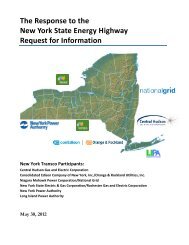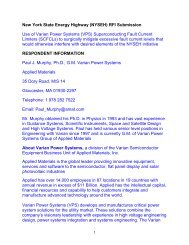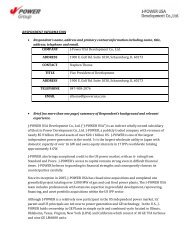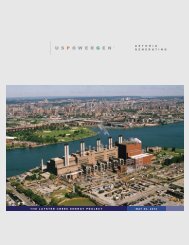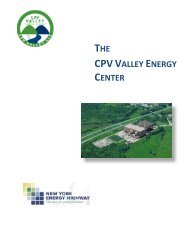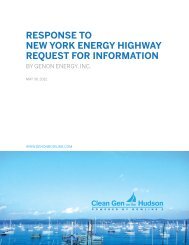Deepwater Wind - Energy Highway
Deepwater Wind - Energy Highway
Deepwater Wind - Energy Highway
You also want an ePaper? Increase the reach of your titles
YUMPU automatically turns print PDFs into web optimized ePapers that Google loves.
!<br />
!<br />
• Supports development of a new green industry in downstate New York;<br />
• Satisfies approximately 52% of New York State’s remaining 2015 RPS goal and<br />
100% of LIPA’s 2020 renewable energy supply goal;<br />
• Satisfies LIPA’s entire greenhouse gas emissions reduction target;<br />
• Diversifies downstate New York’s electric fuel supply; and<br />
• Provides long-term supply flexibility.!<br />
Offshore <strong>Wind</strong> Plant. DWEC will consist of 150 WTGs, each with a nameplate capacity<br />
of 6 MW, and will be built in two arrays of 450 MW each, for a total of 900 MW.<br />
<strong>Deepwater</strong>’s analysis demonstrates that the Project site could accommodate up to 200<br />
WTGs, allowing for future expansion. DWEC is the most advanced second-generation<br />
offshore wind plant in the United States and is widely expected to be one of the first<br />
utility-scale offshore wind farms to receive permits and site control. Given its location in<br />
a high wind-speed area, the 900 MW <strong>Wind</strong> Plant will have a capacity and peak<br />
coincidence factors that are superior to those of near-shore offshore wind plants and that<br />
far exceed those of land-based wind farms in the Northeast.<br />
Controllable HVDC Transmission Network. NELI is modeled after similar offshore<br />
networks that have been proposed in Northern Europe and elsewhere. Using<br />
commercially tested technologies similar to those already in use in New York, NELI is a<br />
600 MW HVDC transmission facility that will connect the Brayton Point, Massachusetts<br />
high-voltage substation in ISO-NE with LIPA’s Shoreham substation, and will include an<br />
offshore substation to which DWEC will interconnect and deliver power. The distance<br />
from Brayton Point to the <strong>Wind</strong> Plant is approximately 38 miles; and from the <strong>Wind</strong><br />
Plant to Shoreham, approximately 98 miles.<br />
The Shoreham interconnection point has a number of advantages including adequate<br />
space for the location of a converter station, direct access to Long Island Sound, and<br />
sufficient electrical capacity to handle a new 600 MW interconnection without the need<br />
for significant upgrades. Additionally, interconnecting at Shoreham increases the<br />
efficiency of the LIPA transmission system by supplying the under-served eastern load<br />
pocket and by more fully utilizing the transmission infrastructure that is currently in<br />
place.<br />
NELI not only enables LIPA to receive the benefits of firm power by firming an<br />
intermittent wind resource, it also enhances the economic efficiency of DWEC by<br />
improving the utilization of the <strong>Wind</strong> Plant’s transmission infrastructure and providing<br />
Zone K access to cost effective supply in the ISO-NE market.<br />
Supply of Firm Power and Zone K Capacity. The 900 MW <strong>Wind</strong> Plant will deliver<br />
power to the NELI offshore substation and the first power generated, up to NELI’s 600<br />
MW limit, will be transmitted to Zone K. With <strong>Deepwater</strong>’s Project, NY-ISO’s Zone K<br />
will receive a firm block of 600 MW of power, most of which will be generated by<br />
DWEC. During periods when the output of the <strong>Wind</strong> Plant is greater than 600 MW, the<br />
!<br />
8




